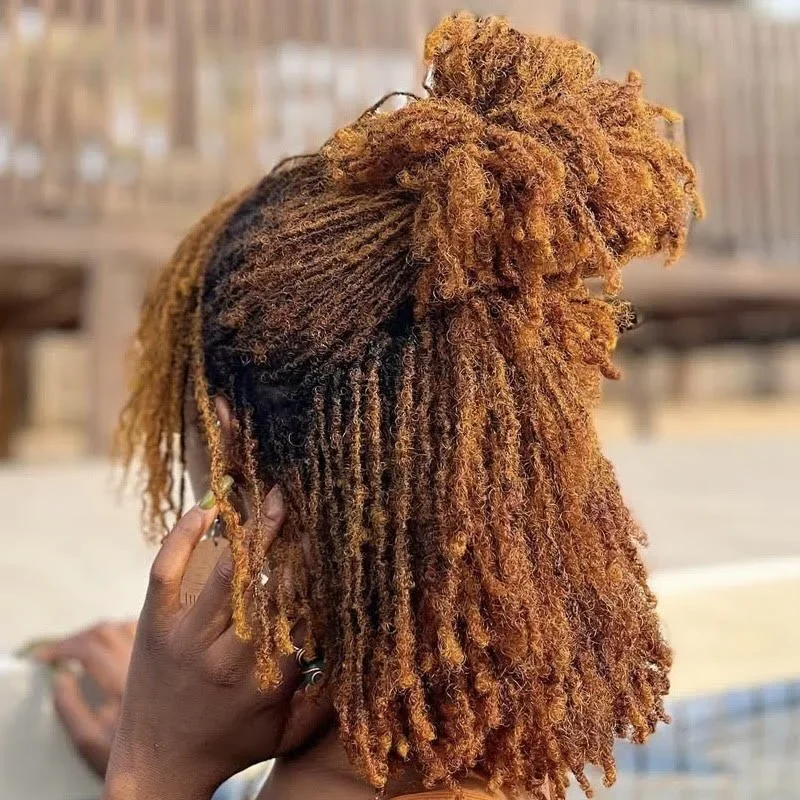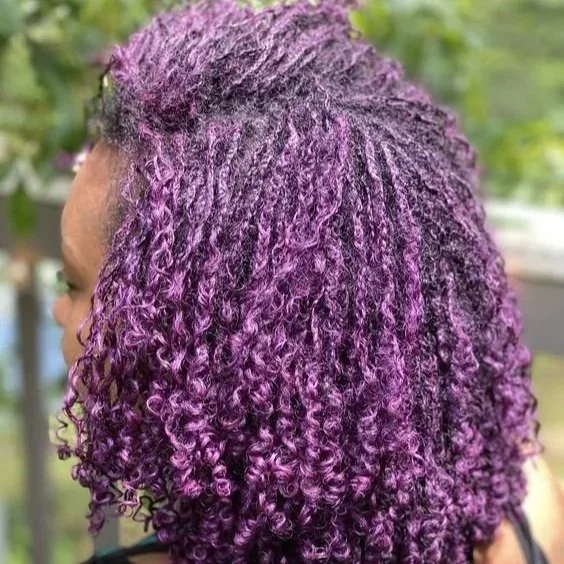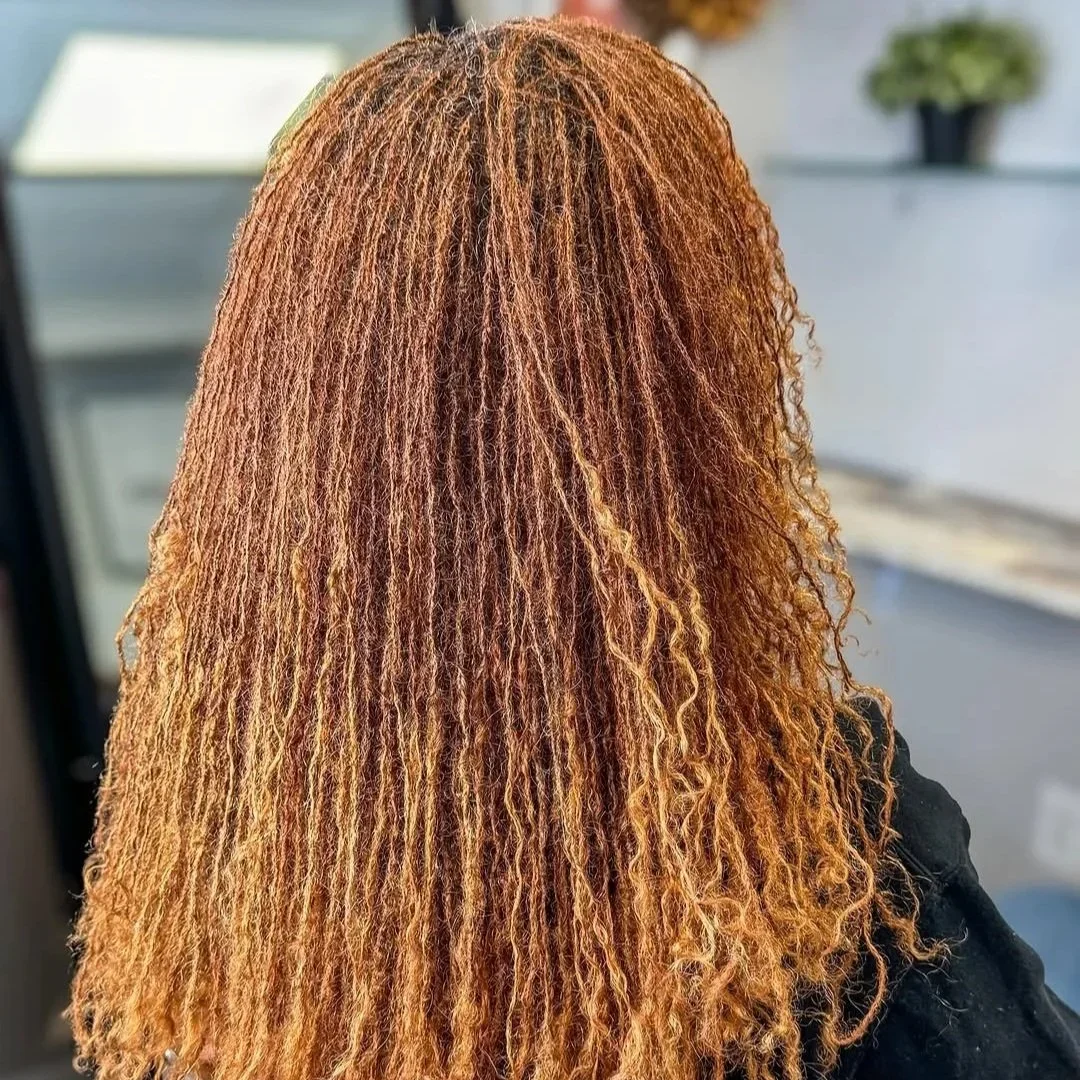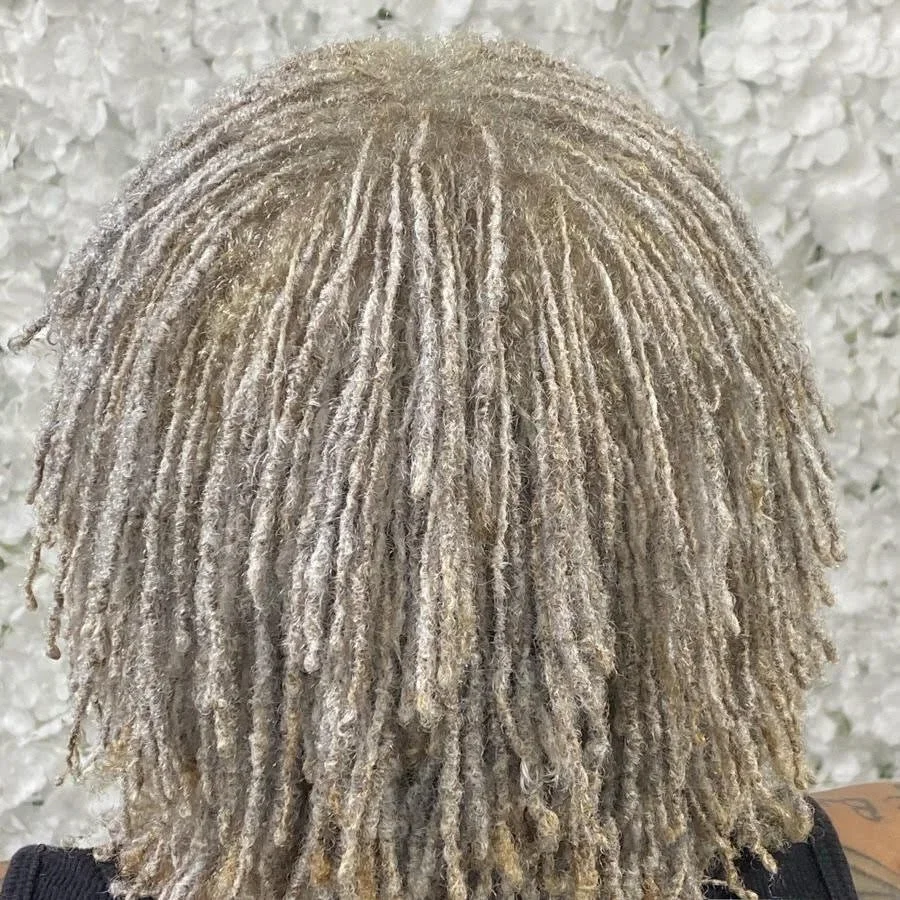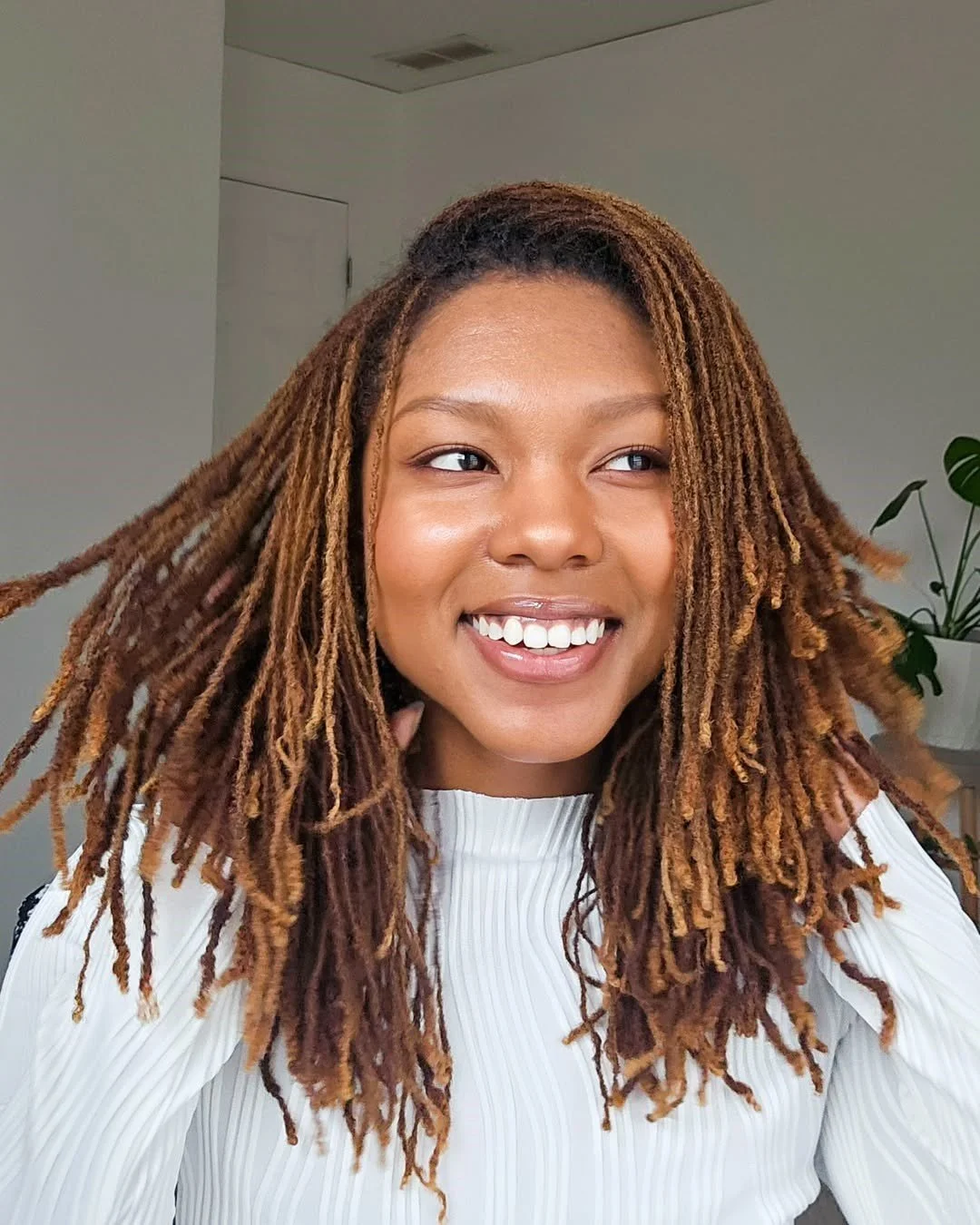Everything You Need to Know About Coloring Your Microlocs or Sisterlocks Safely
It’s no secret how versatile microlocs and Sisterlocks are. From accessories to hairstyles, the options are endless, but when was the last time you thought about color? If you’re dye-ing for a change, Omalocs Beauty has you covered with expert-backed tips and best practices for safely adding color to your microlocs or Sisterlocks.
Because microlocs are smaller and more delicate, coloring requires a gentle, customized approach. With the right technique, timing, and aftercare routine, you can achieve a vibrant look without compromising the health or integrity of your locs.
Top Reasons People Dye Their Microlocs
Before bringing out the gloves and developer, take a moment to think about why you want to color your microlocs. Whether it’s for self-expression, a fresh seasonal vibe, or simply “just because,” adding color is one of the easiest (and most fun) ways to refresh your look. To help you get inspired, we’ve rounded up a few of the top reasons people love experimenting with hair color on their locs.
Express Personal Style: Experimenting with color is a bold and effective way to quickly enhance your appearance and try something new.
Celebrate a Milestone: Color can be a great way to celebrate different milestones along your loc journey. Typically, microlocs take up to 12-18 months to reach maturity. Adding color can be a fun way to applaud your growth, patience, and commitment.
Embrace Seasonal Changes: Summertime blonde. Auburn for autumn. As the seasons shift, adding color can be an expressive way to evolve your look throughout the year. It’s perfect for anyone who loves variety, embraces change, and enjoys giving their microlocs a new vibe every few months.
Accentuate or Conceal Greys: Grey hairs are a beautiful indication of wisdom and age, but sometimes you may want to touch them up. Adding color is a nice way to highlight your silver strands or reintroduce your natural or new color.
Camouflage Lint Build-up: Thoroughly removing lint can be difficult and picking them out can weaken your microlocs. Coloring your hair a darker color is an easy way to cover the lint, with minimal damage.
Restore Vibrancy: The sun is a natural coloring agent and can change the color of your hair over time. Adding color is an easy way to color correct and revitalize your ideal tone.
When Is the Best Time to Color Microlocs or Sisterlocks?
The age or maturity of your locs plays a big role in determining the safest time to add color. Coloring immature or starter microlocs too early can lead to damage, slippage, or even unraveling. The best times to color your microlocs are either before installation or once they’ve fully matured. If you are determined to add some color to your hair before the 12-month mark, consider temporary or semi-permanent dye, as it’s a great way to experiment with color while keeping your locs healthy.
Before Installation (immediately before or after your initial consultation)
Coloring your natural hair while it’s still loose is the safest option for coloring, as the dye will not interfere with your locking process (though it may alter the texture of your hair and impact the method you use to start your locs). You may want to retouch the new growth as your locs grow and mature.
Starter Locs (1 - 11 months)
If you must, temporary color waxes or semi-permanent dye can be used during this stage, as chemicals can be damaging to your locs. Coloring only the tips or end of your hair is also a safer option, though keep in mind that these areas are the most fragile and may be prone to breakage.
Mature Locs (12 - 24 months)
Adding color after your locs have fully matured is also a good option. By this stage, the hair has fully locked and strengthened, making it more resilient to chemical processing.
Professional vs. DIY Microlocs Coloring Methods
Professional Coloring Methods:
The most trusted option for dyeing your locs is going to a professional loctician or colorist who specializes in microlocs or Sisterlocks. Visiting a specialist comes with pros like getting a custom color mix, receiving proper saturation, and safe lightening. The professional approach can increase the chances of getting a color that complements you and your vision, the likelihood of the dye penetrating your locs properly, and the protection of your hair from bleach and chemicals.
DIY Coloring Methods:
DIY coloring can be a cost-effective way to dye your locs at home using temporary wax, henna, and box dyes. When choosing an option that works best for you, you’ll want to consider the potential risks. We’ve listed a few of the most common options from least to most risky.
Temporary Wax / Paint: A great and non-committal way to try a new color. With this method, the color coats the surface of the loc, sitting above the strands. Since the color can be removed by shampooing, this is a great no-chemical option to color your hair. Please note that temporary hair waxes and paints can often stain your clothes. See the process in action with this temporary wax dyeing video.
Henna & Indigo: Natural and residue-free options that give your locs a reddish-orange and blue-black tint respectively. Though the chemical risks are minimal, henna and indigo are permanent, and they require thorough rinsing. It is important to note that with this technique, it may be difficult to chemically lighten your hair in the future. Learn how to restore your hair color and loc health with this henna and amla coloring video.
Sun-bleaching: A gradual and subtle approach to dyeing your locs using a natural method. Also known as “photobleaching,” this process results in a mix of rust-colored red and brown hues, resembling a sun-kissed look. To help with the lightening process, some people spritz their hair with lemon juice before laying out in the sun. It’s important to note that the areas that receive more sun will be a slightly different shade than those that don’t, resulting in highlights / un-even coloring.
Box Dye: Box dyes are widely available but they typically contain high concentrations of chemicals that can be too harsh for fine locs. If misused, results may be patchy, contain color buildup, and cause severe dryness. See how you can safely refresh your look with this in-depth, bleach-free, root touch-up video.
(Chemical) Bleaching: An effective, yet aggressive approach to lifting color in your locs. This process is achieved by stripping your hair’s natural pigment, which can lead to chemical damage if not done with care. Bleaching may also cause severe breakage, thinning, and unraveling (if done on starter locs). For a detailed breakdown of how to best bleach your hair watch this no-damage, step-by-step bleaching and coloring video.
Regardless of the option you choose, coloring your microlocs by yourself can be a fun and affordable option. We’ve complied a few of our favorite DIY coloring videos from microlocs creators below:
@destinytaylorxoxo: Dark & Lovely, Jet Black, Fade Resist Box Dye
@msaliciajames: Bigen, Oriental Black, Permanent Powder Hair Color
@asoul.tv: Adore, Crimson + Intense Red, Creative Image, Semi-Permanent Bottle Dye
@si_locked_in: As I Am, Copper, Temporary Curl Color Gel
@kendraykenshay: KAISASA Black 3 in 1 Hair Dye Shampoo, Cover Greys
Potential Risks of Coloring Microlocs and Sisterlocks
Coloring your microlocs or Sisterlocks is exciting, but there are potential risks that can arise during or after the process. Here are the most common issues to look out for, to keep your locs healthy and vibrant.
Breakage & Thinning: Bleach and permanent dyes can strip your locs of essential moisture and protein, leaving them more fragile. Additionally, the coloring process can cause your microlocs to break off completely if they are already weak or thin.
Unraveling & Slippage: Premature coloring can compromise your locs’ integrity and ultimately interrupt the locking process.
Residue Buildup: Locs are highly porous, meaning they absorb moisture quickly. If dye is not rinsed thoroughly, it can cause permanent residue buildup, resulting in a muddy color within the hair.
Allergic Reactions: Always assess how the dye takes to your hair and skin by performing a patch test 24 - 48 hours before coloring your full head.
How to Care for Colored Microlocs or Sisterlocks
To restore moisture and reduce color fading, implement an intentional aftercare routine. Here are a few things you can do to maintain your hair color.
Moisturize: Deep condition your hair after thoroughly rinsing the dye to restore strength.
Shampoo: Use color-safe, residue-free shampoos to support the longevity of your hair dye.
Protect: To preserve the pigment and prevent the color from fading over time, limit washes to every 1 - 2 weeks.
Refresh: Use color-depositing conditioners to revive your hair color between appointments. This is a calmer approach to re-dying your entire head of hair.
Aftercare is just as important as coloring. With a thoughtful routine, your hair color will maintain its longevity, while your locs remain healthy and strong. See what an ideal routine looks like with this wash day routine for color-treated microlocs video from EnToi Beauty below.
Microlocs & Sisterlocks Color Inspiration and Styles
Coloring your microlocs comes with endless possibilities. Whether you’re going bright and bold or keeping it soft and neutral, whether you color your full head or just the tips, there are countless ways to style and enhance your new hair color. We’ve included some of our favorite colorful looks to spark some inspiration and add some color to your day!
Dyeing your microlocs or Sisterlocks is a great way add vibrant color to your hair. Always be sure to consult your loctician to discuss all of your options and find the best method for you. With an intentional approach, coloring your locs can be the stylish and unique change needed to refresh your look.

